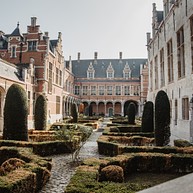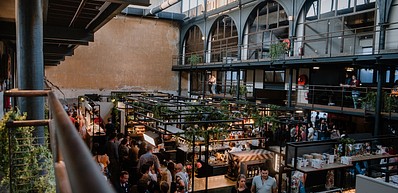
-
![Kazerne Dossin Mechelen]() Provided by: Visit Mechelen
Provided by: Visit Mechelen

Our travel guides are free to read and explore online. If you want to get your own copy, the full travel guide for this destination is available to you offline* to bring along anywhere or print for your trip.
*this will be downloaded as a PDF.Price
€4,95
Kazerne Dossin
The guide was updated:Between 1942 and 1944 Kazerne Dossin was used by the Nazis as a SS assembly point. Here more than 25,000 Jews and gypsies were put on the train for Auschwitz-Birkenau. Now it is the site of the new Memorial, Museum and Documentation Centre on the Holocaust and Human Rights, designed by leading architect bOb Van Reeth. At Kazerne Dossin the tragic war-time events are linked to human rights in general and to the theme of hope.
Useful Information
- Address: Goswin de Stassartstraat 153, 2800 Mechelen
- Website: www.kazernedossin.eu
- Phone: +32 15 29 06 60
Digital Travel Guide Download
Our travel guides are free to read and explore online. If you want to get your own copy, the full travel guide for this destination is available to you offline* to bring along anywhere or print for your trip.
*this will be downloaded as a PDF.Price
€4,95

After 538 steps, you’ll be on the Sky Walk which affords a panoramic view of the Grote Markt and indeed the whole city. On your way to the top, stop and catch your breath in six rooms, each of which serves a different purpose. Take the opportunity to admire from close to the working tower clock and two carillons. There’s nothing like them in Europe!
Read more

Museum Hof van Busleyden
Welcome to the Museum Hof van Busleyden! Step into this majestic and magnificent Renaissance palace in Mechelen, the capital of the Burgundian Netherlands. Find out more about the surprising Burgundian history as you venture deeper into the Hof van Busleyden, discovering its treasures and stories. Learn more about the Burgundians’ ideas, about the city, about power and about mastership and craftsmanship. Move from lively and bustling rooms to more private and quieter places.
In this museum we look back at the city’s glorious history and look ahead to the future, together with you. Travel back and forth, between the past and present. Experiment and engage in a dialogue with the museum and its ever-changing collection. The story is far from finished.
Read more

Palace of Margaret of Austria
History and architecture enthusiasts will feel at home in Mechelen straightaway, particularly when it comes to viewing the palaces of Margaret of York and Margaret of Austria! The residence of the regent Margaret of Austria, the Court of Savoy, was the first renaissance building in the Low Countries. The picturesque garden is a wonderfully peaceful place. On the other side of the street is what remains of the Palace of Margaret of York.
Read more

Dyle path
The people of Mechelen like to enjoy their city and why not! A walk alongside the water in the heart of the city is a unique and relaxing experience, particularly if you walk over the floating part of the Dyle Path! The path leads past (and over) the Dyle, between Haverwerf and the Botanical Garden. See a different side of Mechelen — the backs of the old houses! The many water birds make it atmospheric and fun for children too.
Read more

Large and Small Beguinages
Beguines are women who lived together and together sustained themselves. The charming, narrow streets of the beguinages are an oasis of peace and a wonderful place for a quiet stroll. Its typical Flemish character and unusual architecture ensured the Large Beguinage of a place on UNESCO’s list of world heritage sites.
Read more

In the footsteps of Margareta
Travel five hundred years back in time to the days when Mechelen was the capital of the Netherlands. As the city was also the seat of Margareta of Austria’s court, scores of Burgundian noblemen settled here too.
This prosperous period left its mark on the city and traces of it have survived to this day, including Burgundian palaces, historic churches, wooden façades and sumptuously decorated guildhalls. This handy brochure brochure takes you back to that rich Burgundian era.
Read more

Boat trip on the Inner Dyle
For a whole new take on the city centre, opt for a boat ride from Haverwerf through the marina and the sluice dock. Look out for the Vismarkt (Fish Market), the Grootbrug (Large Bridge), the Botanical Garden and the Volmolen or Fuller’s Mill. You’ll see how the people of Mechelen live in historic waterside buildings: imagine how wonderful it must be to have a house overlooking the Dyle.
Read more

Kazerne Dossin
Between 1942 and 1944 Kazerne Dossin was used by the Nazis as a SS assembly point. Here more than 25,000 Jews and gypsies were put on the train for Auschwitz-Birkenau. Now it is the site of the new Memorial, Museum and Documentation Centre on the Holocaust and Human Rights, designed by leading architect bOb Van Reeth. At Kazerne Dossin the tragic war-time events are linked to human rights in general and to the theme of hope.
Read more

Het Anker brewery
On the edge of the beguinage you’ll find Het Anker, the authentic brewery where the Gouden Carolus is brewed. Charles V’s favourite tipple back in the sixteenth century, in 2012 this specialist beer won the gold medal at the World Beer Awards.
Read more

The eight historical churches
Mechelen has churches galore and each contains a profusion of religious treasures. There are no fewer than eight historical churches in the city centre, each well worth a visit! The coloured light which filters through the stained-glass windows and the serene atmosphere which pervades the buildings make a visit a very special experience. The churches also contain works of art, including famous paintings by Rubens and Van Dyck. The latter provided St Rumbold’s Cathedral with a veritable masterpiece: the ‘Crucifixion of Christ’.
Read more

The Fish Market and Lamot site
If you’d like to see something of authentic Mechelen, do as the Mechelaars do and soak up the atmosphere around Lamot brewery. The old brewery was converted into an ultramodern conference and heritage centre and is a wonderful example of how our industrial heritage can be put to new use. For Mechelen’s trendiest spots, head for the convivial Vismarkt - or Fish Market - on the other side of the Dyle. When the sun’s out, it’s a great place to enjoy it.
Read more

Haverwerf
Originally oats were unloaded and traded here. Oats used to be synonymous with grain and Mechelen had the exclusive staple rights to grain. Boats carrying grain had to tie up in Mechelen and offer the whole cargo for sale for three whole days.
You can't fail to notice the three houses near the bridge. They date from the 16th and 17th centuries. The corner house is called Het Paradijske, Little Paradise. The reliefs above the windows depict the scenes 'Earthly paradise' and 'The tree of knowledge of good and evil'. In the middle is De Duiveltjes, The Little Devils, one of the most beautiful wooden façades in the country. We know that it used to be called De Verloren Zoon, The Prodigal Son, because the story is depicted above the front door. Enjoy the waterside!
Read more

Zoutwerf
When the city acquired the staple for salt in 1301, the historic quay on the Grootbrug or Large Bridge was renamed the 'Zoutwerf' or Salt Wharf.
You will immediately notice the two authentic façades of 'De Waag' and 'De Steur'. De Steur served as a warehouse, while the goods were weighed in De Waag ('Weighhouse').Another striking building is the former guildhall of the fishmongers, 'In den Grooten Zalm' – In the Large Salmon. The 'Innehuysken' to the right of 'De Waag' is where the 'innegeld' – 'monies received' – was paid, an early form of taxation. The building was destroyed by fire in the 17th century, but the fishmongers pulled together, rebuilt it and renamed it 'De Kleine Zalm', 'The Small Salmon'.
Read more

Foodmarket: De Vleeshalle
The concept "Shop-Taste-Meet" brings people together in the unique historical framework of “De Vleeshalle”, an old market hall build in 1881. All your senses kick in here: sight, sound, smell and of course taste! You’ll be amazed at the wide range of authentic and irresistible foods available in the former ‘Meat Hall’. Doing your regular shop here is a far cry from the supermarket routine. It’s an experience to relish!
Read more

Royal Manufacturers De Wit
The world-famous De Wit Royal Manufacturers of Tapestry is an absolute ‘must’. For four generations antique tapestries have been cleaned and conserved here using state-of-the-art technology. On Saturday mornings visitors can take a look inside the workshop and watch a weaving demonstration.
The House of Refuge of Tongerlo Abbey dates from the 15th century. These days the building houses the Royal Manufacturers De Wit, a world-famous tapestry- weaving and restoration workshop. If the gate is open, step into the beautiful garden. You will see a number of plants growing which are depicted on historical tapestries.
Read more

Aldermen’s Building
As the first stone town hall to be built in Flanders, Mechelen’s Schepenhuis is steeped in history. In the 13th century it served as the town hall and meeting place of the municipal court of justice and in the 15th century as the seat of the Great Council and the Parliament of Mechelen.
Municipal academy, museum, city archive and city library, the building went on to perform numerous other roles. In September 2018 the building saw its latest incarnation as the brand-new home of Visit Mechelen, the tourist information office. It is manned by experts on the local area who help visitors get the most out of their visit to Mechelen, so it is the ideal first port of call. It is also conveniently located between the four central points of the city: the Grote Markt, IJzerenleen, St Rumbold’s Tower and the Bruul.
Read more

Mechelen Toy Museum
The Toy Museum houses one of the largest collections of toys in Europe. You’ll find toys from all over the world, old and new. Children are amazed at the toys their grandparents used to play with and for adults they bring nostalgic memories of childhood flooding back.
Read more

Town Hall
The modern-day town hall is actually two buildings: Cloth Hall with its unfinished belfry (recognised by UNESCO) and the Palace of the Great Council. But in fact Mechelen has three town halls: the old Schepenhuis or Aldermen’s House, Huis Den Beyaert and the modern-day town hall. Then there is the Huis van de Mechelaar, the brand-new administrative centre.
Read more

ZOO Planckendael
If you want to get out of the city for a while, head for ZOO Planckendael, where you can admire exotic animals, follow a trail that leads across suspension bridges and through the treetops. In the 40-hectare park there is more than enough space for animals to frolic, children to play and adults to stroll.
Read more

Technopolis
Have you always wanted to try your hand at landing an aeroplane? Would you dare to take a nap on a bed of nails or ride a bicycle along a high wire 5 metres above the ground? At Technopolis®, the Flemish hands-on centre for science and technology, (almost) anything is possible.
Read more

Winter Garden of the Ursuline nuns
We have no idea what prompted the Ursuline nuns in Onze-Lieve-Vrouw-Waver to make the rather bold decision to build this truly magnificent Art Nouveau building. After all, this style was considered hyper-modern in 1900. And yet, this enchanting Winter Garden with its colourful stained glass cupola was considered the most stunning feature of their boarding school. What’s even more intriguing is that nobody knows who designed the Winter Garden. And yet the architect’s design skills are unparalleled.
Don’t believe us? Well, come take a look for yourself because this is Art Nouveau at its most resplendent.
Read more

House of Refuge of St Trond’s Abbey
Very early on the abbots of abbeys and monasteries had refuges built in the walled towns where they could stay during a visit to that town or on their way to their often extensive landed estates. In times of war, these refuges also offered protection. The House of Refuge of St Trond's Abbey was established by the Benedictine Abbey in the 16th century to improve contact between the abbey and the archbishop. These days this beautiful building is part of the archbishop's palace to which it is linked by means of a covered bridge.
Read more

The Cells
In the shadow of St Rumbold's Tower is a unique historical monument. 'De Cellekens' was originally a charitable institution which took in needy women without a family to care for them. The three wings form a U-shape around the magnificent enclosed garden. Originally each door provided access to two small rooms with bed, cupboard, chair and table. The institution derives its name from these little 'cells'.
'De Cellekens' was empty for a long time but then the new owners, artist Mariette Teugels and her photographer husband Herman Smet, restored the building. You can see some of Mariette Teugels' work in the new garden.
Read more

Grootbrug
The Grootbrug or Large Bridge, also known as the Hoogbrug - High Bridge, connects the IJzerenleen on the other side with the Korenmarkt. This sandstone structure dating from the thirteenth century is the oldest stone bridge in Flanders. The Grootbrug used to be a toll bridge; payment was exacted both on the water and on the street. The bases of two small defence towers are still visible. The Guldenstraat, Korenmarkt and Hoogstraat lead in a direct line from the Grootbrug to the Brusselpoort, the only surviving city gate.
Read more

Groen Waterke
There are many idyllic spots in Mechelen and Groen Waterke is one of them. The brook owes its name to the duckweed which covers the surface of the water. It is in fact the remains of the Melaan brook which was not covered over or filled in here. Enjoy the peace and quiet of this idyllic spot, close to the houses of refuge of St Trond and Tongerlo abbeys.
Read more

Watch Museum & Clock Clinic
The Watch Museum is a museum with a difference. The Op de Beeck family restores antique clocks and watches and over the centuries has amassed a large collection of timepieces dating from 1600 to the present day. The collection contains extraordinary tower clocks, mystery clocks, sundials and much much more. To find out just how much more, you'll have to pay a visit to this atmospheric museum! You can even have a guided tour. But keep an eye on the time!
Read more

The Mad Art Collection
This historical building houses a museum with a permanent collection of sixteenth-century paintings. What makes the collection unique is that each painting contains a satirical and moralising reference to 'madness'. There are paintings in the style of Hieronymus Bosch, Bruegel and Brouwer illustrating reprehensible behaviour and the appropriate punishment. You'll have fun trying to work out the meaning of all the symbols.
Read more


